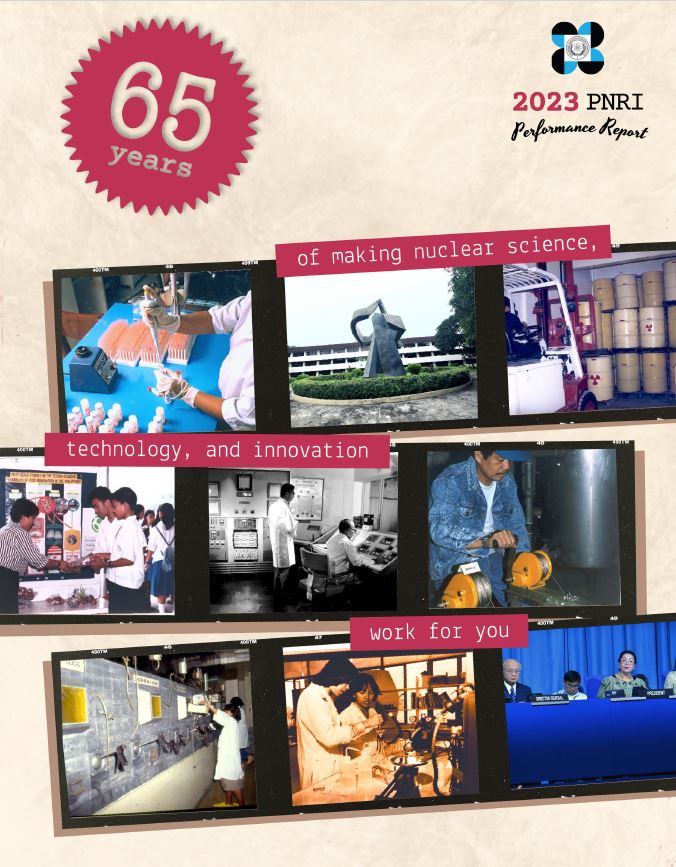Mr. Fernando Aurigue, Scientist I of the DOST has been doing mutation breeding for many decades. In this photo, he shows one of the propagated mutant “calachuchi” varieties.
New mutants bloom at PH nuclear agency
DOST-PNRI developed two new varieties of Plumeria through mutation breeding. The varieties are now registered with the National Seed Industry Council (NSIC), Bureau of Plant Industry and at the Mutant Variety Database of the International Atomic Energy Agency.
More popularly known as “frangipani” or temple flower in English and “calachuchi” in Filipino, Plumeria rubra in the scientific world has new babies at the Philippine Nuclear Research Institute (PNRI) of the Department of Science and Technology (DOST). With their enhanced looks and scent, the new blooms will surely capture the hearts of flower lovers, especially the “calachuchi” fans.
Meet “Illuminance” and “Radiance,” both borne using the nuclear technique called mutation breeding. That they were bred through irradiation technology is what makes them different from the usual neighborhood “calachuchi.”
Most “calachuchis” grown today for planting onsite start as stem cuttings. Illuminance and Radiance started as seeds. But unlike hybrids, they took on a different path - they were exposed to a certain dose of gamma rays before germination to produce novel traits.
The traits of both blooms were not planned nor designed. They were the results of the effects of radiation applied to the planting material. Radiation altered or modified the plant’s’ genetic make-up which resulted in a new trait that can be preserved through vegetative propagation of the plant or inherited by its offsprings.
To ensure that the desirable traits are stable and can be passed on to the next vegetative generations, each generation was evaluated on the evident changes.
“We observed exactly the same mutated characteristics with each vegetative generation advancement for six generations,” explained Mr. Fernando B. Aurigue, Scientist I and lead of the Ornamental Plant Mutation Breeding project. “For “calachuchi,” six vegetative generation advancements took three to six years.”
Improved desirable traits
“Illuminance” and “Radiance” have improved traits in growth habit, flower color, and scent.
The original and non-irradiated control Plumeria rubra has white blooms with yellow center. They also bear the scent that is associated with deaths and funerals that is most prominent at night until morning.
But not for these new babies. As an improved version, the flowers of Illuminance look very elegant and feminine. The white petals are lined with a purple-pink swatch that vanishes into the middle of the flower with a yellow center.
Meanwhile, Radiance glows with its summery look-- pure white petals with a radiant yellow center.
Both have a delectably sweet scent. The trees are compact in growth habit and bloom almost all year round with peak of flowering during the dry months.
Long, careful study
But a big load of patience is required in mutation breeding. Greater effort was most needed for generation advancement and stability testing parts of the study.
“The experiment actually started in 2009,” revealed Sir Nanding, as he is fondly called at PNRI. “We tried different doses of gamma rays and determined the best one.”
“At 30 Gray, traits are already evident. At higher doses, the seedlings died or the seeds did not germinate at all,” he said.
Gray is a unit of radiation dose. A dose of 1 Gy is equivalent to a unit of energy or joule deposited in a kilogram of a substance (or matter). For example, a chest X-ray comprises 20 microGrays (µGy), while eating a banana which naturally contains potassium-40 gives 0.1 µGy.
The right radiation dose applied in the right conditions produced the beautiful mutants whose traits consistently came through across at least six vegetative generations.
“Plumeria ‘Illuminance’ (NSIC 2021 Or 101) and P. ‘Radiance’ (NSIC 2021 Or 102) are now registered with the IAEA Mutant Variety Database with ID numbers 4943 and 4944, respectively,” informed Sir Nanding.
He likewise acknowledges the help of Mr. Luis Mauricio Alfonzo-Godoy of IAEA for facilitating the processing of the Mutant Variety Registration Forms.
Why “calachuchi”?
Mr. Aurigue has a long experience in mutation breeding, starting in 1986 as a researcher at the Institute of Plant Breeding, College of Agriculture, University of the Philippines in Los Baños, Laguna. He has worked extensively on several ornamental plants such as Dracaena braunii, more popularly known as cornplant or lucky bamboo, Mussaenda or the “Doñas”, and most especially on hoyas.
He also worked on mutation breeding in fruit crops such as mangosteen and cashew, cereal crops such as rice and adlay, and application of radiation-modified kappa-carrageenan on crops such as peanuts and mungbean.
Why this study on “calachuchi”? The reason is simple and so down-to-earth.
“There is currently no one making a study on mutation breeding of “calachuchi.” I want to be the pioneer,” he explained. “It is every researcher’s dream to be the first to come up with results from a study on a certain subject. With available planting materials, I took the opportunity.”
He also said that cross-pollination is the usual way of breeding “calachuchi,” but there are yet no registered varieties produced using said method in the Philippines.
“’Calachuchi’” looks beautiful throughout the year,” he added. Indeed, “calachuchi” trees can be seen along most roadsides, parks, and public spaces in the country.
Now, through the awesome technology of mutation breeding by gamma irradiation, flower lovers will enjoy new sweet-smelling eye candies which can help spur horticulture and landscaping industries abloom in the country. (Framelia V. Anonas / Photos by PNRI-Nuclear Information and Documentation Section)
|
Fast Facts: It has many comparative advantages: it is cost-effective, qauick, proven and robust. It is also transferrable or heritable, ubiquitously applicable, non-hazardous and environmentally friendly. (Source: International Atomic Energy Agency) More than 3,330 mutant varieties – including numerous crops, ornamentals and trees – have officially been released for commercial use in more than 230 plant species from over 70 countries (Source: FAO/IAEA Mutant Varieties Database). |
|
“Illuminance” has a very elegant and feminine look, its white petals lined with a purple-pink swatch that vanishes into the middle of the flower, highlighted with a yellow center. |
“Radiance” glows with its refreshing summery look-- pure white petals with a radiant yellow center. |















































